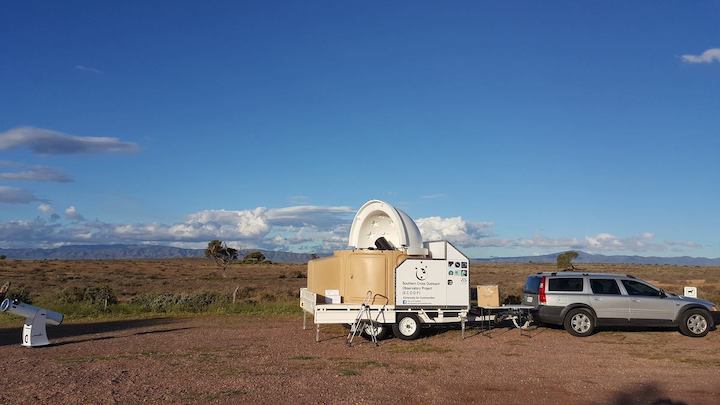13.03.2021
An innovative proposal might make all the difference to de-junking near-Earth space.

A network of mobile observatories deployed across Australia’s vast expanse could be a new weapon in the battle against dangerous space debris.
The Southern Cross Outreach Observatory Project (SCOOP) already takes a mobile observatory – towed by an SUV – into communities to teach people about astronomy.
Project founder Muhammad Akbar Hussain presented the idea to the Inquiry into Developing Australia’s Space Industry this week, and hopes to create a detailed database of where space junk is – and where it’s going. The next step would be to use high-quality data to de-orbit debris with lasers.
SCOOP’s submission to the Parliamentary inquiry describes it as “a network of special purpose mobile observatories capable of rapid deployment in remote areas to visually track space debris and develop a comprehensive and accurate database of their orbits and trajectories”.
Low Earth Orbit (LEO) is getting increasingly busy, sparking concerns about Kessler Syndrome, where runaway collisions between spent rockets, satellites and other junk could cripple access to LEO.
Flinders University space archaeologist Alice Gorman – known as “Dr Space Junk” – says Kessler Syndrome was the “worst-case scenario”, and would have very significant consequences.
“If LEO became unusable that would mean a lot of LEO satellites that we rely on for weather management, bushfire management… would be severely compromised. Telecommunications satellites might not work,” she says.
SCOOP, a not-for-profit science initiative, uses its 2.3m observatory to promote the space industry but thinks the idea could be extended to Space Situational Awareness.
“A network of mobile observatories (using optical, infrared, radar, imaging, astrophotography, etc.) can be remotely linked to each other to create one large instrument,” Hussain notes.
Deploying the equipment quickly to remote locations would fill a gap in space observation by finding the best positions, taking into account the weather, light pollution, the trajectory of specific junk, and other variables.
Hussain gives the example of an observatory in southern Western Australia picking up the object/s, which can then be followed by another station in Central Australia and another further north. A second transit could be tracked by units moved along the calculated trajectory of the debris.
“The acquired data can then be uploaded and processed to create details maps of the accurate positions of space debris for any given time in (the future),” he writes.
“This data can be used to calculate the expected time of transit and attributes of trajectory of a debris of concern for ground-based laser systems to the highest level of precision. This will help these systems to deorbit the debris with pinpoint accuracy by choosing the type of laser, its wattage and exact direction.
“Multiple laser beams from different locations focusing on a single piece of debris may make this process even quicker.”
Gorman says there are already optical observatories and “a huge number of people actively tracking space debris” – including LeoLabs in New Zealand the Exmouth Telescope in WA.
“But it’s recognised that our data is very poor, there are huge chunks of stuff that we can’t track or identify,” she says.
“The idea of having mobile observatories is a great one… because we (in Australia) have the land mass and the expertise and the capability it would make a lot of sense. That could be one component of many.”
She said it might not be as simple as creating a mobile array and deploying it, but that Hussain’s idea was the “sort of creative thinking we ought to be encouraging”.
“The worst-case scenario is the Kessler Syndrome, in which there’d be a self-sustaining cascade of collision that would continue and create more junk even if we didn’t launch anything more into orbit,” Gorman says, pointing to the launch of “mega-constellations” of satellites – such as SpaceX’s Starlink – clogging up space, where objects travelling at 7–8km a second can cause extraordinary damage.
“That makes launching things into LEO particularly dangerous.”
Gorman also applauds SCOOP’s outreach work.
“Given the political obstacles to getting any sort of agreement on how to manage space junk, public support is really critical to getting something done,” she says.
Quelle: COSMOS
